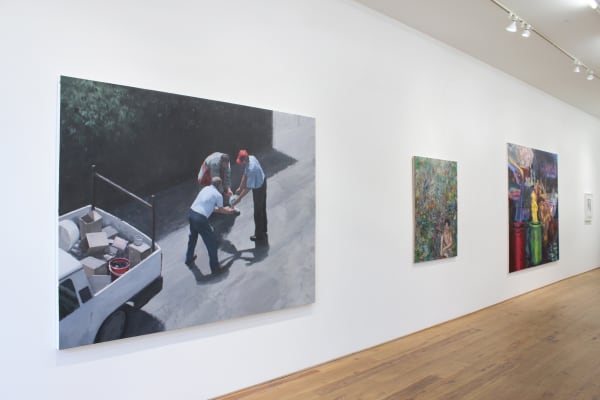Shadowland
Past exhibition
Installation Views
Press Release
Eastern European Artists of the Post-Communist Era
Jānis Avotiņš, Marius Bercea, Zsolt Bodoni, Josef Bolf, Matija Brumen, Robert Fekete, Adrian Ghenie, Ion Grigorescu, Elvis Krstulović, Marin Majić, Ciprian Mureşan, Djordje Ozbolt, Volha Panco, Daniel Pitin, Șerban Savu, Leonardo Silaghi, Alexander Tinei, Josef Tirić, Zlatan Vehabović
The rapid acceleration of technological development, specifically the transition of social spaces into the digital realm, has amplified the need to become brand strategists of selfhood, to piece together an avatar that stands proud as a differentiated product in the social marketplace. This digital puppeteering has stripped the human environment down to a composite of facades, surroundings that are seen rather than felt and captured rather than experienced as the assumption of identity shifts from organic growth to logical production. Where does this leave the physical, feeling being? Are we fading into the shadows as these simulated ideals take form, degenerating into hypnagogic phantoms with dwindling connection to bodily and spatial rhythms? Are we allowing the great puppeteer of algorithmic affirmations to steer us towards an unrecognizable existence?
In the last fifteen years, rampant technological progress has united development with dissolution, blurring perceptions of reality between the physical and digital into a newfound ecosystem of pixelated ghosts. No period of history has paralleled this dramatic environmental shift quite like the fall of Communism in Eastern Europe. "Catch-up modernization" required the rapid assumption of both a sociocultural and individual capitalist identity, diving directly into contemporary hyper-individuality and leaving behind shadows of an exiled yet ever-present past. As a show predominantly of artists born at the cusp of Communism's collapse and growing up during this period of ideological transition, Shadowland engages with themes of individual and cultural alienation that, especially to young viewers struggling with the assumption of identity in a virtual world, have taken on new meaning 35 years later.
Ciprian Mureşan's film, Dog Luv, which premiered in the Romanian Pavilion at The Venice Biennale in 2009, adapts the namesake text by Saviana Stǎnescu to the puppet theater, with its all-black color palette serving to collapse puppeteer and puppet into one body. After critiquing the human race for its self-destructive tendencies and reciting an exhaustive list of strategies/techniques of violence, the dogs stage a torturous uprising against their leader, Maddog, assuming the human tendencies they once mocked. This film, building unsettling tension between humor and horror, questions and ridicules power's contagious nature and the pervasive pressures of conformity, layering interior drives with exterior influences into a multidimensional performance of cruelty.
Robert Fekete's We Have the Same Feelings nests image within image and environment within environment to probe into the process of seeing. His four figures, gazing at or through a canvas-window hybrid, interact with the waterfall as mimetic product, cleaved from its essence through a perceptual translation that manifests in two-dimensional dullness. With this natural landscape devoid of sensory intimacy and encased in rectangular borders, Fekete's work interrogates our relationship to embodied experience, confronting the viewer with an alienated existence comprised of flattened moments. Whereas Fekete presents the seen in its final alienated form, Zlatan Vehabović's July 17th fixes that which is seen and that which is felt in their process of progressive divergence, with fragmenting forms and spectral discharge straddling the production and destruction of schematic totalities. Whether hollowing out into ready-at-hand givenness or bursting forth with extra-visual resonances, Vehabović builds tension between the facades and fleeting substance that characterizes the contemporary environment's individual parts.
With 100 Years, Zsolt Bodoni pieces these parts together into wholes that further investigate the human-environmental disconnect, constructing vignettes whose objects, figures, and architecture abstract into apparitions on the cusp of either becoming or evanescing. Toying with different degrees of detail that stimulate the imagination, Bodoni presents his subjects as foreigners in their urban skin, with compromised memories diluting what were once known as new realities, straddling the past and future with an uncertain present.
Adrian Ghenie's early work, If You Open It, You Get Dirty, pushes Bodoni's environmental abstractions to their extreme, with subtle changes in brush stroke and a few black lines splicing an otherwise monochromatic piece. While his 2010 piece, Study for The Kaiser Wilhelm Institute 1, literally defaces the historic German political figure with Ghenie's characteristic torturous satire, If You Open It, You Get Dirty takes a different approach to horror, compacting his later works' bombastic power into the ambiguities of omission. Whether in the first stages of germination or taking its final breath, If You Open It, You Get Dirty contains spirits that whisper with the anguish of a repressed past and foreseeable nothingness.
Lastly, Belarusian painter Volha Panco blasts into this unknown void with speculative images of post-human ecosystems, where tensions between construction and destruction, growth and withering, unite as markers of a symbiotic destabilization unfiltered by human consciousness. Panco, having transitioned from more figurative representation to abstract orchestration, breathes life into her landscapes with layered passages of lived time, with pigment and form functioning to fossilize the past into a future where chaos simultaneously reigns and reorganizes itself.
Shadowland is emblematic of how artists often provide a window into their times, echoing the dissociative angst of societies in marked transition. The newer generation of artists has grown up without the memories and connections to Eastern Europe before the fall, their characteristic optimism reflecting itself across mediums. The recent right-wing swing has given a voice to politicians threatening a regression to limited freedoms, and it remains to be seen how the artistic environment will shift to orient itself in this destabilized socio political climate. It is with art, that we can often confront and reconcile with the varied conditions of contemporary life, to understand how the past and uncertain future manifest in the present, to accept human history with all its weaknesses and find within it a courageous fortitude.
by Evan Karas








